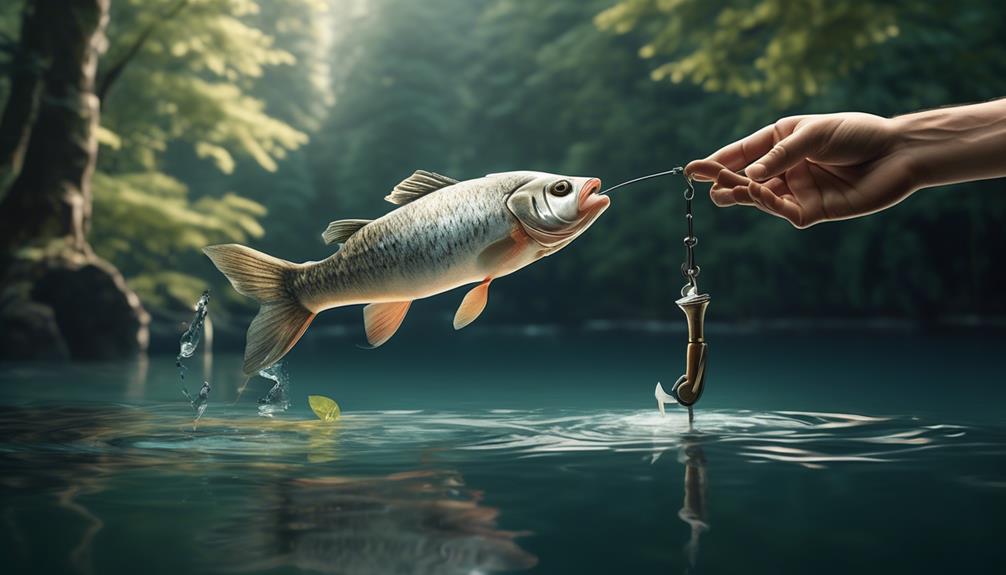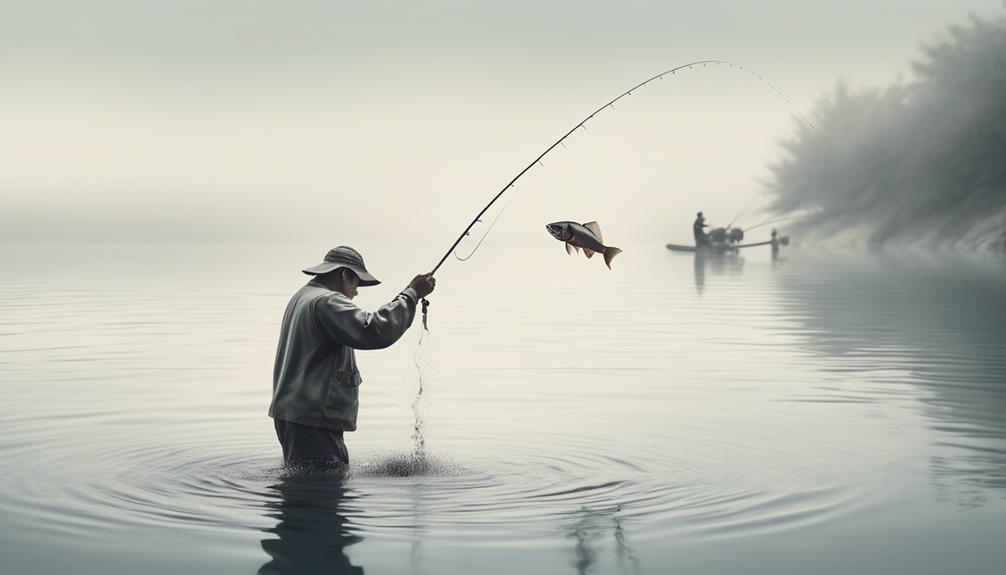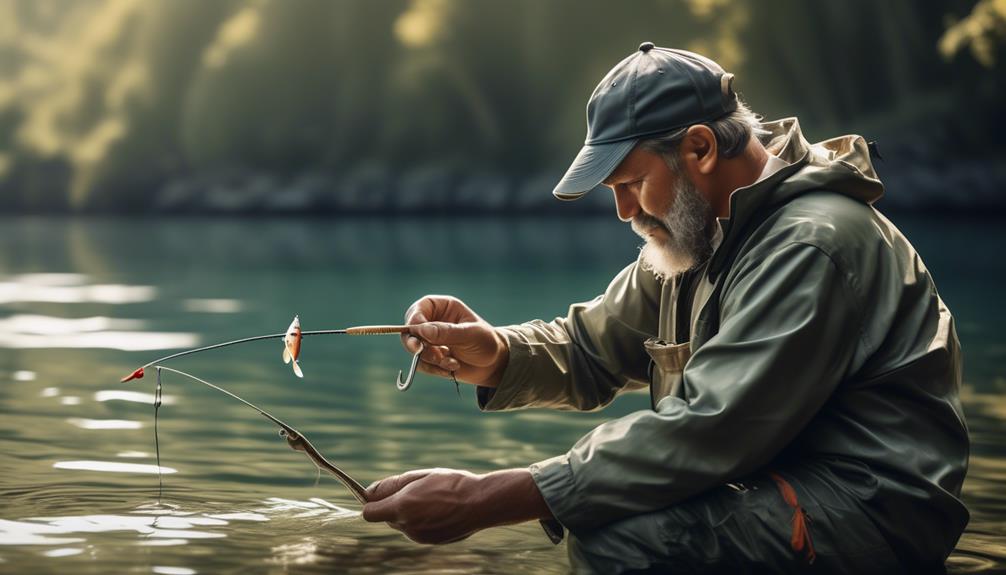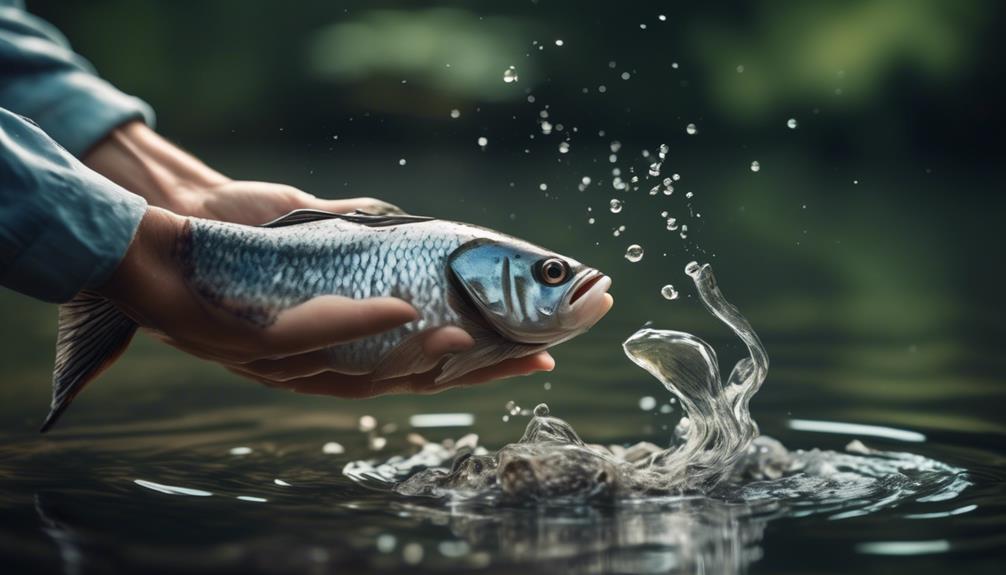So, you've just reeled in that prized catch and are feeling the satisfaction of a successful day out on the water. Now, it's time to release the fish back into its natural habitat.
But do you know the best practices for ensuring the fish's survival post-release?
In this article, we'll provide you with 10 essential tips to uphold catch and release ethics, allowing you to make a positive impact on the environment and preserve the future of recreational fishing.
Understanding Catch and Release
Understanding catch and release fishing is essential for preserving fish populations and promoting sustainable angling practices. Conservation efforts rely on the responsible practice of catch and release to ensure the long-term health of fish species and their habitats. When anglers engage in catch and release, they're actively contributing to the environmental impact of their recreational activity. By releasing fish back into the water unharmed, anglers help maintain the natural balance of aquatic ecosystems and support the overall health of fish populations.
Catch and release involves carefully handling the fish to minimize stress and injury. This includes using barbless hooks, minimizing the time the fish is out of the water, and avoiding contact with the fish's sensitive gills. Understanding these techniques is crucial for the successful implementation of catch and release. Additionally, being aware of the best practices for reviving exhausted fish ensures that they've the highest chance of survival after being released.
Conservation efforts also rely on anglers understanding the specific regulations and guidelines for catch and release in their area. This may include restrictions on certain species, size limits, or designated catch and release areas. Adhering to these regulations helps support sustainable fish populations and contributes to the overall health of the aquatic environment.
Proper Handling Techniques
To ensure the success of catch and release fishing and minimize harm to fish, it's crucial to master proper handling techniques that reduce stress and injury to the fish.
When handling a fish, always wet your hands to prevent removing the protective slime layer on the fish's skin. This slime layer is vital for the fish's protection against bacteria and parasites. Dry hands can remove this layer, leaving the fish vulnerable to infection and disease.
It's also essential to handle the fish gently and support its body weight. Avoid putting excessive pressure on the fish's gills or internal organs.
When removing the hook, do it quickly and efficiently to minimize the fish's stress and prevent unnecessary injury. If the fish is deeply hooked, consider cutting the line rather than pulling the hook forcefully, as this can cause severe damage.
Additionally, if you need to take a photo of the fish, keep it close to the water and limit its time out of the water to prevent harm.
Always release the fish as soon as possible, using a gentle and controlled motion to allow it to swim away strongly.
Selecting the Right Gear
When choosing your fishing gear, consider selecting equipment designed specifically for catch and release to minimize harm to the fish.
Gear selection plays a crucial role in ensuring the ethical practice of catch and release. Start by using barbless hooks, which cause less damage to the fish and make hook removal easier. Additionally, opt for non-stainless-steel hooks, as they can corrode and disintegrate over time if a fish isn't able to shake the hook loose. This reduces the risk of long-term injury to the fish.
When it comes to fishing lines, choose those that are strong enough to handle the targeted fish species but are also thin to minimize potential damage. Monofilament lines are a good choice as they're less likely to cause deep hooking and are more visible for easy retrieval.
In terms of ethical considerations, prioritize using landing nets made of rubber or knotless mesh to prevent removing the protective slime layer from the fish. This layer helps protect fish from infections and parasites. Furthermore, consider carrying a pair of long-nose pliers to safely and quickly remove the hook from the fish's mouth, minimizing handling time.
Lastly, using a proper release tool, such as a dehooker or a release weight, can aid in reviving and releasing the fish with minimal stress.
Educating Others on Ethics
Share your knowledge of catch and release ethics with fellow anglers to promote responsible fishing practices and conservation efforts. Educating awareness about the importance of catch and release practices is crucial in ensuring the sustainability of fish populations. When engaging in discussions with other anglers, emphasize the significance of handling fish with care and releasing them unharmed back into their natural habitat. Promoting understanding of the potential impact of catch and release practices on fish populations and the overall ecosystem can encourage others to adopt ethical fishing practices.
One effective way to educate others on catch and release ethics is by leading by example. Demonstrate proper handling techniques and emphasize the use of barbless hooks and appropriate tackle to minimize harm to the fish. Additionally, take the opportunity to explain the rationale behind these practices, such as reducing stress on the fish and increasing their likelihood of survival after release. Encouraging others to join in these efforts can help create a community of responsible anglers dedicated to conservation.
Another way to educate fellow anglers is by sharing educational resources and information on catch and release best practices. This could include distributing pamphlets, sharing online articles, or organizing informational sessions. By providing accessible and relevant information, you can empower others to make informed decisions and take part in sustainable fishing practices.
Minimizing Environmental Impact
Demonstrate your commitment to ethical fishing practices by considering the environmental impact of catch and release, aiming to minimize harm to the ecosystem. When practicing catch and release, it's crucial to focus on reducing stress on the fish and preserving their habitats. Minimizing environmental impact not only ensures the health of the fish population but also contributes to the overall balance of the ecosystem.
To reduce stress on the fish, handle them with care and minimize the time they spend out of the water. Always wet your hands before touching the fish to protect their delicate skin and scales. Use barbless hooks to make the unhooking process smoother and less harmful to the fish. Additionally, avoid squeezing the fish or putting excessive pressure on their bodies when handling them, as this can cause internal injuries and stress.
Preserving habitats is essential for the long-term sustainability of fish populations. When fishing in a certain area, be mindful of the surrounding environment and avoid damaging aquatic vegetation, as it serves as a crucial habitat for many species. Refrain from wading in shallow areas where fish may be spawning, as this can disturb their breeding grounds. Furthermore, properly dispose of any fishing line, hooks, or other equipment to prevent them from entangling or harming wildlife.
Adhering to Local Regulations
To ensure ethical fishing practices, always adhere to local regulations regarding catch and release, respecting the guidelines set forth to protect the ecosystem and maintain sustainable fish populations. Researching regulations and following guidelines is crucial to ensure that you're in compliance with local laws and regulations.
Here are some essential tips to help you adhere to local regulations:
- Research the specific catch and release regulations for the area where you plan to fish. Different regions may have varying rules regarding the type of fish that can be caught and released, as well as size and quantity limits.
- Respect boundaries and designated areas where catch and release may be permitted. Some areas may have no-fishing zones or restricted areas to protect vulnerable fish populations or sensitive habitats.
- Familiarize yourself with the proper handling and release techniques for different fish species. Some regulations may include specific guidelines for releasing fish safely to maximize their chances of survival.
- Stay informed about any updates or changes to local regulations. Laws and guidelines can evolve based on the health of fish populations and the overall ecosystem, so it's essential to stay current with any revisions.
Supporting Conservation Efforts

Ensure that your commitment to ethical fishing practices extends to actively supporting conservation efforts within the local ecosystem. Conservation awareness is crucial for the long-term health of fish populations and their habitats. By staying informed about local conservation initiatives and participating in relevant programs, you can contribute directly to the sustainability of the environment.
One way to support conservation efforts is by staying informed about the state of local fish populations and their habitats. Stay updated on conservation news, research, and initiatives in your area. This knowledge will help you make informed decisions about where and when to fish, ensuring that you avoid fragile or overexploited areas.
Another way to actively support conservation efforts is by practicing sustainable fishing methods. This includes using barbless hooks, minimizing the time fish spend out of the water, and handling them with care to minimize stress and injury. Additionally, consider joining or supporting local conservation organizations that work to protect and restore fish habitats.
Lastly, spread conservation awareness within your fishing community. Encourage others to embrace catch and release practices and respect local regulations. By promoting the importance of conservation, you can inspire others to adopt sustainable practices, ultimately contributing to the preservation of the natural environment for future generations.
Reflecting on the Experience
After practicing ethical fishing and releasing a catch, take a moment to reflect on the experience and appreciate the connection you've formed with nature. Personal reflection and considering the ethical considerations of catch and release fishing can enhance your overall experience and deepen your appreciation for the natural world.
Here are some tips for reflecting on your catch and release experience:
- Consider the Impact: Ponder on the impact of your actions. Reflect on how your adherence to catch and release ethics has contributed to the conservation of fish populations and their habitats. Acknowledge the role you play in preserving the natural balance of aquatic ecosystems.
- Appreciate the Encounter: Take a moment to appreciate the beauty of the fish species you encountered. Reflect on the privilege of witnessing these creatures in their natural habitat. Consider the significance of the interaction and how it has enriched your understanding of the environment.
- Evaluate Your Techniques: Reflect on the techniques you employed during the catch and release process. Consider whether there are any improvements you could make to minimize stress on the fish and enhance its chances of survival after release.
- Gratitude for Nature: Express gratitude for the opportunity to engage in ethical fishing practices. Reflect on the serenity and tranquility of the natural surroundings and the privilege of being able to enjoy them responsibly. Consider how this experience has deepened your connection with nature and reinforced your commitment to conservation efforts.
Taking the time to reflect on your catch and release experience can foster a sense of mindfulness and stewardship towards the environment, enriching the overall impact of your fishing endeavors.
Frequently Asked Questions
How Can I Ensure That the Fish I Release Will Survive Once It's Back in the Water?
To ensure the fish you release survives, proper fish handling is crucial. Support the fish in the water until it can swim on its own. Minimize air exposure and never touch the fish with dry hands.
Avoid removing the fish from the water if possible. Use barbless hooks and avoid using a net.
Implementing these release techniques and best practices will greatly increase the fish's chances of survival.
Are There Any Specific Guidelines for Catching and Releasing Different Types of Fish, Such as Trout Versus Bass?
When trout fishing, it's important to follow specific guidelines for catch and release to ensure the fish's survival. Different types of fish may have varying needs when it comes to releasing them back into the water. Likewise, bass fishing requires careful handling to uphold ethical and conservation efforts. By adhering to these guidelines, you can contribute to the preservation of fish populations and maintain ethical fishing practices.
What Are Some Common Mistakes That Anglers Make When Practicing Catch and Release, and How Can I Avoid Them?
When practicing catch and release, avoid some common mistakes like mishandling fish, using improper gear, and keeping fish out of water too long.
To minimize harm, handle fish gently, use barbless hooks, and keep fish in the water as much as possible. Survival tips include wetting your hands before handling fish and using needle-nose pliers to remove hooks.
Species guidelines also matter, so research specific fish for best practices.
Is There a Specific Time of Year When Catch and Release Should Be Avoided to Minimize Stress on Fish Populations?
To avoid stressing fish populations, it's important to know when catch and release should be avoided.
During spawning seasons, like spring for bass, it's best to minimize handling and release. This helps protect the fish and ensure healthy reproduction.
How Can I Encourage Other Anglers to Adopt Catch and Release Practices Without Coming Across as Judgmental or Preachy?
Encouraging other anglers to adopt catch and release practices without being judgmental or preachy involves building community and sharing experiences.
You can lead by example, sharing the positive impacts of catch and release on fish populations and the overall fishing experience.
Approach conversations with empathy and understanding, and offer to share tips and techniques.
Conclusion
Now that you have the knowledge and tools to uphold catch and release ethics, it's time to put them into practice.
Remember to handle fish carefully, use the right gear, and educate others about the importance of ethical fishing practices.
By following these tips, you can help protect fish populations and ensure that future generations can enjoy the thrill of fishing.
Happy angling!



